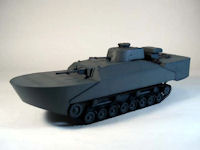Type 5 To-Ku amphibious tank
The last Japanese amphibious tank, which was planned to be adopted at the very end of the war, was the Type 5 "To-Ku". It was a rather unusual combat vehicle that combined units and assemblies of serial production tanks. The chassis "To-Ku" was actually borrowed from the medium tank "Chi-Ri" and consisted of 8 dual support rollers blocked in pairs in 4 trucks, 3 supporting rollers, the front drive and rear guide wheels. To ensure buoyancy, the hull had to be made high, and metal pontoons were installed in the front and aft of the hull, like a Ka-Mi tank . Armor on the front of the hull was 50 mm, the front of the turret 25 mm.
The armament of the To-Ku, for its size and mass, was not powerful enough. A 47-mm Type 1 cannon and a 7.7-mm machine gun were installed in the hull, a 25-mm naval-type cannon and a stern machine gun were placed in the single-seater turret. The mask of the gun was covered with special covers. A telescopic sight was used for aiming. A radio station with a whip antenna and an internal intercom were installed. The tank was equipped with a 12-cylinder diesel engine Type 100, air-cooled, 240 hp with a mechanical type transmission.
At the beginning of 1945, they managed to build and begin testing a prototype of the To-ku floating tank, but its mass production was never established. The tank appeared too late to go into series production.
| Classification | Amphibious tank |
| Manufacturer | Japan |
| Issued by | 1 PC. |
| Years of operation | 1945 |
| Main operators | Imperial Army of Japan |
| Combat weight | 29.1 t |
| Crew | 7 people |
| Body Length | 10 800 mm (with floats) |
| Hull width | 3,000 mm |
| Height | 3,888 mm |
| Caliber and type of gun |
|
| Machine guns | 7.7 mm Type 97 |
| Engine type | "Type 100", 12-cylinder, diesel, air cooled |
| Highway speed | 32 km / h |
| Speed over rough terrain | 10 km / h (afloat) |
| Suspension type | Hara Suspension |
| Overcoming ford | Swims |
|
NEWSLETTER
|
| Join the GlobalSecurity.org mailing list |
|
|
|


